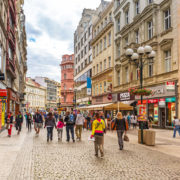What are the Czechs like 30 years after the Velvet Revolution and how has the Czech Republic changed over the years? Academics in analysis for Czech Radio tried to answer this.
The aim of Czech Radio’s research was to find out what is the structure of Czech society, and what social classes can be found in it.
Results show that Czechs divide themes like migration or pro-Western direction. Research highlights that the theme of a divided society was fully opened by the first direct presidential election, underlined by the (social) change triggered by the economic crisis, and accelerated the migration process.
Discussion of pro-Western direction
Since the ’90s, topics of an economic nature have dominated the Czech public debate and political divisions; an economic nature that has shaped the perception of the left and right. However, emphasis on economic issues has diminished due to the establishment of the market and skepticism caused by the crisis.
“This opened the door for new cultural themes such as migration or globalization, but it also, partly, returned the debate to the question of the country’s pro-western direction. These topics have become a significant part of the political struggle,” said the analysis.
According to research, Czech society is determined not to head for the East, but Czechs are also uncertain whether it is even possible to go their own way.
The topic on which Czechs agreed, and became the subject of public debate in 2018, is environmental protection. The debate has been aggravated by drought, climate change, and bark beetle calamity.
“Czechs have long been positively committed to environmental protection, and four-fifths of the public believe that man-made climate change threatens our future. Here, the Czech public is completely united even across classes. The difference is partly in the willingness to invest in environmental protection at the expense of their own comfort,” says the research.
Drug addicts are a problem
The analysis also focused on what Czechs keep the distance from. Results show that Czech society does not support people addicted to drugs. 67 percent of the population would not accept drug addicts as visitors to the Czech Republic.
“The Czechs have the second biggest distance to Muslims, which 38 percent of respondents said they would not admit to the Czech Republic and 34 percent would only admit as visitors. Followed by Gypsies, 25 percent of respondents would not allow into the Czech Republic, and 25 percent accept them as citizens of the Czech Republic at maximum, ”says the analysis.
Drug addicts, Muslims, and Gypsies are perceived as the most unacceptable groups by Czechs.
Six classes are forming in the Czech Republic
Classes in the Czech Republic are another thing described in this research. In addition to income and wealth, researchers have found out people’s contacts and social ties. “These social ties can help you face crises and get better-paid jobs or other benefits,” explains the research.
The six classes forming differ significantly. There are two types of the upper-middle class. The first is secured by its income and property (the secured middle class). The second has less wealth but greater potential for the future, as it can strengthen through strong social contacts, cultural capital, language and digital skills (the emerging cosmopolitan class). Together, these two prosperous classes account for about a third of society.
“There are also three types of lower-middle-class that makeup half of the Czech population. It is a traditional working-class that has a solid income and wealth, but limited other resources such as contacts, cultural capital, new competences, and an endangered class that is on the contrary, socially and culturally. It is more of a middle class but economically it suffers,” says the analysis.
Specifically, the local bonds class that benefit from a combination of owned property and contacts in their neighborhood can help the lower-middle class. Every sixth Czech aged between 18 and 75 then falls into the lowest class – the so-called deprived class. This class lacks all types of capital – income, wealth, social contacts and new types of competence and human capital.
The class structure varies by region. More than half of Prague’s inhabitants belong to the two upper middle classes, while around half of the inhabitants of the Karlovy Vary and Ústí nad Labem regions belong either to the deprived class or to the endangered class, which is very economically unstable. On the other hand, the class of local ties—benefiting from contacts and assistance from its surroundings—is widespread in the rural Highlands and the religious South Moravia.
The analysis for Czech Radio was created by a team of sociologists. The survey on 4039 respondents was conducted in June 2019 by MEDIAN and STEM / MARK. It was attended by respondents from more than 1,300 municipalities and towns throughout the Czech Republic. The research was conducted through a combination of online and face-to-face interviews and is representative of the population aged 18-75 years.
Support Prague Morning!
We are proud to provide our readers from around the world with independent, and unbiased news for free.
Our dedicated team supports the local community, foreign residents and visitors of all nationalities through our website, social media and newsletter.
We appreciate that not everyone can afford to pay for our services but if you are able to, we ask you to support Prague Morning by making a contribution – no matter how small 🙂 .




